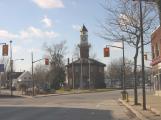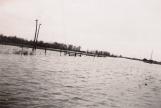1
Thamesville Town Hall
April, 2006
Thamesville, Ontario, Canada

2
In 1937 Southwestern Ontario experienced a mild winter but faced an unusually wet spring. In April, a series of spring rains inundated the county and the water levels in the Thames River slowly began to rise. The resulting flood was triggered by 5 inches of rain that fell from April 24th to the 26th. The three days of torrential rain, combined with the normal spring runoff caused the water levels in the Thames to rise and set new records. London Ontario was the first city to be affected by the rising water levels in the Thames River. On April 26, 1937, the floodwaters of the Thames overran the streets of London forcing thousands to flee their homes. The destruction in the city was so devastating that Londoners called the day, Black Monday. The surrounding area and other towns along the Thames were put on red alert and told to make necessary precautions to prevent similar destruction
3
Thames River
May 14, 1937
Thamesville, Ontario, Canada

4
London Ontario was the first city to be affected by the rising water levels in the Thames River. On April 26, 1937, the floodwaters of the Thames overran the streets of London forcing thousands to flee their homes. The destruction in the city was so devastating that Londoners called the day, Black Monday. The surrounding area and other towns along the Thames were put on red alert and told to make necessary precautions to prevent similar destruction
5
Highway near Thamesville
May, 1937
Thamesville, Ontario, Canada

6
Thamesville had been receiving warnings from the London area for two days but the citizens of this small village were not too concerned. They did not expect the waters heading their way to turn into the worst flood ever recorded in Thamesville’s history. They were aware that the water levels in the Thames were rising and local resident Lloyd Mitton had recorded the following in his diary on April 27, "The river is rising at four inches an hour but we do not expect trouble." By nightfall on the 27th , the river was rising at 6 inches an hour. By morning on the 28th, there was water in the streets of Thamesville as it had begun to pour out of the drains. However, on the other side of the railway track, the water was two feet higher.
7
Flooded Road
May, 1937
Thamesville, Ontario, Canada

8
Canadian National Railway Station
May 7, 1937
Thamesville, Ontario, Canada

9
At the southern edge of the town, the CNR railway tracks acted as a dike to protect Thamesville from the rising waters. The village lies on the north side of the tracks while on the south side of the railway is a vast area of farmland. As the Thames continued to rise its banks became saturated. The water broke over the banks of the river and it began to fill the half-mile of farmland that stretched between the banks of the Thames and the edge of the village. The farmland quickly filled with water and soon the area to the south of the tracks began to resemble a small lake. The town was still protected from the bulk of the floodwaters as the railway levee continued to block the waters from entering the village. However, as was mentioned earlier, the streets of Thamesville were not completely protected from the floodwaters. The Duncan Drain, which ran a line from the Thames, backed up during the night and water began to spill into the streets. This was a regular occurrence in Thamesville and was usually how the streets of the town became flooded. This is why Thamesville residents were probably just expecting minimal flooding. At this point they felt safe because the railway embankment was holding most of the water back and the water coming out of the drains was nothing too serious.
10
Railroad Culver
May, 1937
Thamesville, Ontario, Canada

11
On April 28, 1937, at about 6:00 p.m., the railway dike could no longer hold back the water. It broke through at the east end of the village near a farm owned by the MacDowell family. The floodwaters suddenly rushed into the core of the village and everyone was forced to quickly flee. George Bain, who was around 10 years old at the time, can still recall watching the water break through the railway and the small wave that swept through the town. He was at the railway station at the time and when he saw the water break through the culvert, he knew the flood had turned serious and he rushed home. "By the time I got to the house from the station, the water was up to my knees!" George exclaims, as he recalls how the water within the streets rose up to about 10 or 12 inches.
12
Boy Standing in Water
20th Century, Circa 1954
Thamesville, Ontario, Canada

13
Once the water broke through the railroad there was no escaping the Thames within the town boundaries. Everyone in the town was busy trying to stay dry or keep their belongings dry. George Bain lived next door to Jim Weese who had pet rabbits in cages in his back shed. Once George reached Jim’s house, he helped Jim put the rabbits up higher so they wouldn’t drown in their cages. George then put some fence posts together to make a raft and floated around town to see if he could help in any other way. Store owners quickly worked to put remaining stock up to higher levels and people in their homes tried to raise any furniture as quickly as possible
14
Flooded Land
May, 1937
Thamesville, Ontario, Canada
